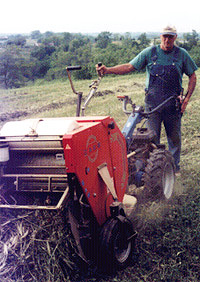UK Project Highlights Low-cost, Multiple Use Equipment for Small Farmers
UK Project Highlights Low-cost, Multiple Use Equipment for Small Farmers

Many farms are over-mechanized or their equipment is inappropriately sized for small-scale or part- time farmers.
A new program to provide training for farmers and University of Kentucky Cooperative Extension Service agents in size appropriate technology is under way across the state.
Equipment is a major farm expense. This program highlights the type of equipment and technology needed for a range of farming size, landscape and enterprises, said Betty King, a UK Extension Rural Economic Development specialist.
The equipment for smaller scale operations being highlighted for this two-year project is multipurpose. Farmers can add pieces as they need them.
"A lot of people are looking for options and we really haven't given them a lot of options," King said. "It's sort of like ‘other-end-of- continuum for precision agriculture designed for hill farms and smaller scale farms."
Some of the equipment highlighted at field days around the state include a two-wheel tractor and a number of attachments including cultivator, hay rake, sickle bar mower, hay baler, bush hog, plastic bed mulch layer and seeder, and plows.
This equipment is not like garden tillers: the two-wheel tractors are much more powerful, King said. These are designed for agriculture – the farming, physical needs and pocketbooks of small, part-time farmers, she said.
Carole Kington was so impressed with the equipment after hosting a recent field day, she and her husband are going to become dealers. Kington, who as a 13-acre farm of various terrains, said she'd read about the small scale equipment in a magazine and wanted to see it.
"I was excited about it, and once I saw it I was really excited about it because it was something I could do," she said.
Greg Tompkins, Cumberland County Extension agent for agriculture and natural resources, said he was not very familiar with the equipment but following a field day in his county he found it impressive.
"It is capable of heavy duty work that is not apparent by looking at it," he said. "It sparked some enthusiasm here especially among women."
Tompkins said the variety of attachments is amazing.
"It's pretty cool to watch that hay baler go across the field spitting out little round bales," he said.
The small scale equipment project was generated during a meeting of the Kentucky Leadership for Agricultural and Environmental Sustainability project (KLAES). A participant had an article about size appropriate equipment and an equipment show in Italy and suggested it was something that may be appropriate for small scale Kentucky farmers, King said.
Produce growers and small vineyard owners are interested in the equipment, she said. Also, it can be a good equipment source for part- time farmers who may be finding it difficult to hire custom work such as baling hay.
The equipment also works well on hillsides that may not be safe for larger pieces of equipment. The size of the equipment also makes it easier for one person, male or female, to hook and unhook the attachments, she said.
Farmers have to think about the farm system and family goals as well as their pocketbook when deciding what routes to take in purchasing equipment, King said.
Some of the small scale equipment may be used as a jointly-owned piece of equipment such as the hay baler which is the most expensive piece but still far cheaper than a conventional baler.
The project is being funded in part by a two-year Sustainable Agriculture Research and Education (SARE) -U.S. Dept. of Agriculture training grant.
"One of the reasons we got the training grant is that we found that extension agents and farmers don't know about this kind of equipment," she said. "We are trying to get out in the state and demonstrate it because we find that once people see it, they are interested in it."
Also, a portable sawmill has been leased through the project, King said. Many small farms have some woodlands and the mill could be used to not only make money but save money by producing lumber needed to construct farm structures. It can also be another way of adding cash flow if a farmer wants to saw lumber for other people.
